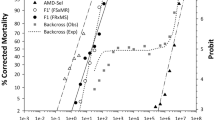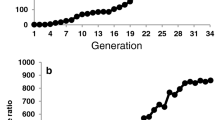Abstract
Spinosad has been used to control Tuta absoluta in Brazil for more than a decade but will eventually be replaced by spinetoram despite the risk of cross-resistance. Therefore, the susceptibility to both molecules and the activity of detoxification enzymes were determined for eight representative populations of T. absoluta to assess resistance and the risk of cross-resistance. The LC50 values for spinosad varied from 0.007 (Pelotas) to 0.626 mg/L (Sumaré); the LC50 values for spinetoram varied from 0.047 (Pelotas) to 0.308 mg/L (Sumaré). The LC99 values for spinosad varied from 0.23 (Pelotas) to 11.56 mg/L (Venda Nova do Imigrante); the LC99 values for spinetoram varied from 0.55 (Pelotas) to 6.71 mg/L (Iraquara). The resistance levels ranged from 1.0- to 93.8-fold (RR50) and 1.0- to 51.5-fold (RR99) for spinosad and from 1.0- to 6.5-fold (RR50) and 1.0- to 12.1-fold (RR99) for spinetoram. The concentration-mortality responses to spinetoram were more homogeneous than those to spinosad. A strong correlation between the susceptibilities of T. absoluta populations to spinosad and spinetoram was observed, showing the similarity of the mode of action of both molecules and producing cross-resistance between them. The β–esterase activity of T. absoluta populations was correlated with spinosyn susceptibility, suggesting a potential contribution of the enzyme to evolved spinosyn resistance. The evolution of resistance to spinosyns in T. absoluta observed in this study suggests that strategies to mitigate resistance must be carefully implemented over the short term and that rotation with other products is encouraged.


Similar content being viewed by others
References
Abbott WS (1925) A method of computing the effectiveness of an insecticide. J Econ Entomol 18:265–267
Arnó J, Gabarra R (2011) Side effects of selected insecticides on the Tuta absoluta (Lepidoptera: Gelechiidae) predators Macrolophus pygmaeus and Nesidiocoris tenuis (Hemiptera: Miridae). J Pest Sci 84:513–520
Balasubramani V, Sayyed AH, Crickmore N (2008) Genetic characterization of resistance to deltamethrin in Plutella xylostella (Lepidoptera: Plutellidae) from India. J Econ Entomol 101:1911–1918
Biondi A, Mommaerts V, Smagghe G, Vinuela E, Zappala L, Desneux N (2012) The non-target impact of spinosyns on beneficial arthropods. Pest Manag Sci 68:1523–1536
Campos MR, Picanço MC, Martins JC, Tomaz AC, Guedes RNC (2011) Insecticide selectivity and behavioral response of the earwig Doru luteipes. Crop Prot 30:1535–1540
Crouse GD, Dripps JE, Sparks TC, Watson GB, Waldron C (2012) Spinosad and Spinetoram, a new semi-synthetic spinosyn. In: Krämer W, Schirmer U, Jeschke P, Witschel M (eds) Modern crop protection compounds: insecticides, vol 3. 2nd edn. Wiley-VCH, Weinheim, pp 1238–1256
Desneux N, Decourtye A, Delpuech J-M (2007) The sublethal effects of pesticides on beneficial arthropods. Annu Rev Entomol 52:81–106
Desneux N, Wajnberg E, Wyckhuys KAG, Burgio G, Arpaia S, Narvaez-Vasquez CA, Gonzalez-Cabrera J, Ruescas DC, Tabone E, Frandon J, Pizzol J, Poncet C, Cabello T, Urbaneja A (2010) Biological invasion of European tomato crops by Tuta absoluta: ecology, geographic expansion and prospects for biological control. J Pest Sci 83:197–215
Desneux N, Luna MG, Guillemaud T, Urbaneja A (2011) The invasive South American tomato pinworm, Tuta absoluta, continues to spread in Afro-Eurasia and beyond: the new threat to tomato world production. J Pest Sci 84:403–408
Finney DJ (1971) Probit analysis, 3rd edn. Cambridge University Press, London
Geng C, Watson GB, Sparks TC (2013) Nicotinic acetylcholine receptors as spinosyn targets for insect pest management. In: Ephraim C (ed) Advances in insect physiology. Academic Press, London, pp. 101–210
Gontijo PC, Picanço MC, Pereira EJG, Martins JC, Chediak M, Guedes RNC (2013) Spatial and temporal variation in the control failure likelihood of the tomato leaf miner, Tuta absoluta. Ann Appl Biol 162:50–59
Guedes RNC, Picanço MC (2012) The tomato borer Tuta absoluta in South America: pest status, management and insecticide resistance. EPPO Bull 42:211–216
Guedes RNC, Siqueira HAA (2012) The tomato borer Tuta absoluta: insecticide resistance and control failure. CAB Rev Perspect Agric Vet Sci Nutr Nat Resour 7:1–7
Habig WH, Pabst MJ, Jakoby WB (1974) Glutathione S-transferases. The first enzymatic step in mercapturic acid formation. J Biol Chem 249:7130–7139
LeOra-Software (2005) POLO-Plus, POLO for Windows computer program, version 2.0. LeOra-Software, Petaluma
Lietti MMM, Botto E, Alzogaray RA (2005) Insecticide resistance in Argentine populations of Tuta absoluta (Meyrick) (Lepidoptera: Gelechiidae). Neotrop Entomol 34:113–119
MAPA - Ministério da Agricultura, Pecuária e Abastecimento (2013) MAPA/CGAF/DFIA/DAS. Accessed 23 Jan
Moulton JK, Pepper DA, Dennehy TJ (2000) Beet armyworm (Spodoptera exigua) resistance to spinosad. Pest Manag Sci 56:842–848
Netter KJ, Seidel G (1964) An adaptively stimulated O-demethylating system in rat liver microssomes and its kinetic properties. J Pharmacol Exp Ther 146:61–65
Perry T, McKenzie JA, Batterham P (2007) A knockout strain of Drosophila melanogaster confers a high level of resistance to spinosad. Insect Biochem Mol Biol 37:184–188
Puinean AM, Lansdell SJ, Collins T, Bielza P, Millar NS (2013) A nicotinic acetylcholine receptor transmembrane point mutation (G275E) associated with resistance to spinosad in Frankliniella occidentalis. J Neurochem 124:590–601
Reyes M, Rocha K, Alarcón L, Siegwart M, Sauphanor B (2012) Metabolic mechanisms involved in the resistance of field populations of Tuta absoluta (Meyrick) (Lepidoptera: Gelechiidae) to spinosad. Pestic Biochem Physiol 102:45–50
Robertson JL, Preisler HK (1992) Pesticide bioassays with arthropods. CRC Press, Inc, Boca Raton, FL
Salazar ER, Araya JE (2001) Respuesta de la polilla del tomate, Tuta absoluta (Meyrick), a insecticidas en Arica. Agric Tech 61:429–435
Salgado VL, Saar R (2004) Desensitizing and non-desensitizing subtypes of alpha-bungarotoxin-sensitive nicotinic acetylcholine receptors in cockroach neurons. J Insect Physiol 50:867–879
Salgado VL, Sparks TC (2005) The spinosyns: chemistry, biochemistry, mode of action, and resistance. In: Lawrence IG, Kostas I, Sarjeet SG (eds) Comprehensive molecular insect science. Elsevier, Amsterdam, pp 137–173
SAS Institute (2001) SAS user’s guide: statistics, version 8.2. SAS Institute, Cary
Scott JG (1989) Cross-resistance to the biological insecticide abamectin in pyrethroid-resistant house flies. Pestic Biochem Physiol 34:27–31
Shono T, Scott JG (2003) Spinosad resistance in the housefly, Musca domestica, is due to a recessive factor on autosome 1. Pestic Biochem Physiol 75:1–7
Sial AA, Brunner JF (2010) Toxicity and residual efficacy of chlorantraniliprole, spinetoram, and emamectin benzoate to Obliquebanded leafroller (Lepidoptera: Tortricidae). J Econ Entomol 103:1277–1285
Siegfried BD, Vaughn TT, Spencer T (2005) Baseline susceptibility of Western Corn Rootworm (Coleoptera: Crysomelidae) to Cry3Bb1 Bacillus thuringiensis toxin. J Econ Entomol 98:1320–1324
Silva GA, Picanço MC, Bacci L, Crespo ALB, Rosado JF, Guedes RNC (2011) Control failure likelihood and spatial dependence of insecticide resistance in the tomato pinworm, Tuta absoluta. Pest Manag Sci 67:913–920
Siqueira HAA, Guedes RNC, Picanço MC (2000a) Cartap resistance and synergism in populations of Tuta absoluta (Lep., Gelechiidae). J Appl Entomol 124:233–238
Siqueira HAA, Guedes RNC, Picanço MC (2000b) Insecticide resistance in populations of Tuta absoluta (Lepidoptera: Gelechiidae). Agric For Entomol 2:147–153
Siqueira HAA, Guedes RNC, Fragoso DB, Magalhaes LC (2001) Abamectin resistance and synergism in Brazilian populations of Tuta absoluta (Meyrick) (Lepidoptera: Gelechiidae). Int J Pest Manag 47:247–251
Smith PK, Krohn RI, Hermanson GT, Mallia AK, Gartner FH, Provenzano MD, Fujimoto EK, Goeke NM, Olson BJ, Klenk DC (1985) Measurement of protein using bicinchoninic acid. Anal Biochem 150:76–85
Sparks TC, Crouse GD, Dripps JE, Anzeveno P, Martynow J, DeAmicis CV, Gifford J (2008) Neural network-based QSAR and insecticide discovery: spinetoram. J Comput Aided Mol Des 22:393–401
Sparks TC, Dripps JE, Watson GB, Paroonagian D (2012) Resistance and cross-resistance to the spinosyns—A review and analysis. Pestic Biochem Physiol 102:1–10
Tabashnik BE, Cushing NL, Finson N, Johnson MW (1990) Field development of resistance to Bacillus thuringiensis in diamondback moth (Lepidoptera: Plutellidae). J Econ Entomol 83:1671–1676
Torres JB, Silva-Torres CSA, Silva MR, Ferreira JF (2002) Compatibilidade de inseticidas e acaricidas com o percevejo predador Podisus nigrispinus (Dallas) (Heteroptera: Pentatomidae) em algodoeiro. Neotrop Entomol 31:311–317
van Asperen K (1962) A study of housefly esterases by means of a sensitive colorimetric method. J Insect Physiol 8:401–416
Watson GB, Chouinard SW, Cook KR, Geng C, Gifford JM, Gustafson GD, Hasler JM, Larrinua IM, Letherer TJ, Mitchell JC, Pak WL, Salgado VL, Sparks TC, Stilwell GE (2010) A spinosyn-sensitive Drosophila melanogaster nicotinic acetylcholine receptor identified through chemically induced target site resistance, resistance gene identification, and heterologous expression. Insect Biochem Mol Biol 40:376–384
Wright RJ, Scharf ME, Meinke LJ, Zhou X, Siegfried BD, Chandler LD (2000) Larval susceptibility of an insecticide-resistant western corn rootworm (Coleoptera: Chrysomelidae) population to soil insecticides: laboratory bioassays, assays of detoxification enzymes, and field performance. J Econ Entomol 93:7–13
Zhao JZ, Li YX, Collins HL, Gusukuma-Minuto L, Mau RF, Thompson GD, Shelto AM (2002) Monitoring and characterization of diamondback moth (Lepidoptera: Plutellidae) resistance to spinosad. J Econ Entomol 95:430–436
Acknowledgments
We thank the CAPES Foundation (Ministry of Education) for financial support and scholarship to the first author, as well as the Conselho Nacional de Pesquisa Científica e DesenvolvimentoTecnológico (CNPq), the IRAC-BR, and Dow Agrochemical Co, for support and donation of insecticide formulations, Prof. Uemerson S. da Cunha and agronomist Celso Ogassawara for collecting material in the field.
Author information
Authors and Affiliations
Corresponding author
Additional information
Communicated by N. Desneux.
Rights and permissions
About this article
Cite this article
Campos, M.R., Silva, T.B.M., Silva, W.M. et al. Spinosyn resistance in the tomato borer Tuta absoluta (Meyrick) (Lepidoptera: Gelechiidae). J Pest Sci 88, 405–412 (2015). https://doi.org/10.1007/s10340-014-0618-y
Received:
Revised:
Accepted:
Published:
Issue Date:
DOI: https://doi.org/10.1007/s10340-014-0618-y




